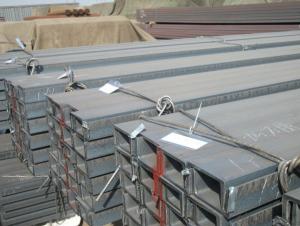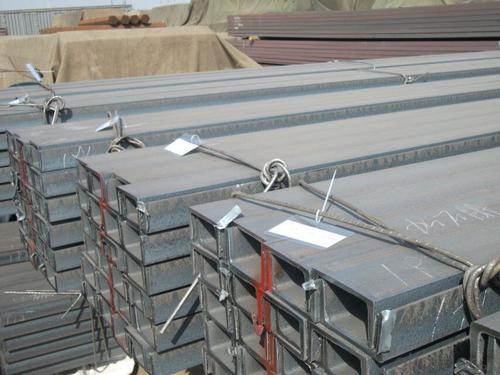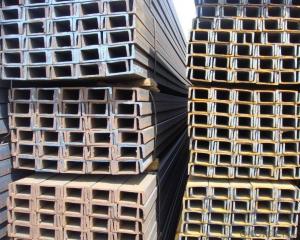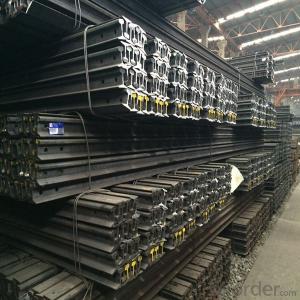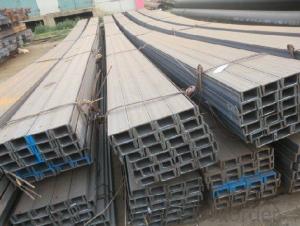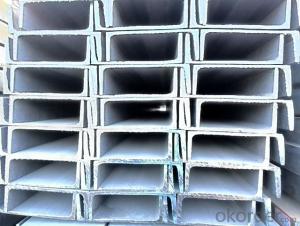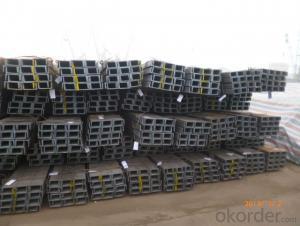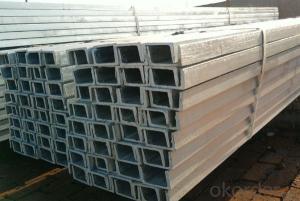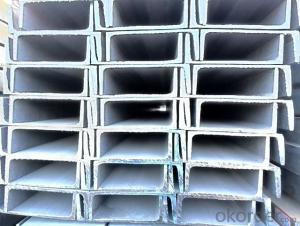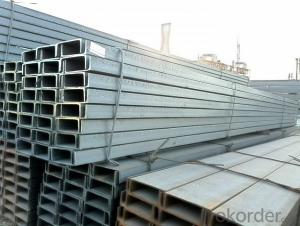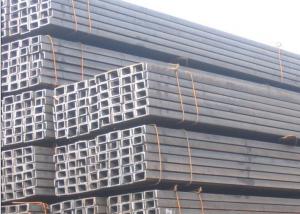U-Channels Hot Rolled with Highest Quality
- Loading Port:
- Tianjin
- Payment Terms:
- TT OR LC
- Min Order Qty:
- 25 m.t
- Supply Capability:
- 10000 m.t/month
OKorder Service Pledge
OKorder Financial Service
You Might Also Like
Specification
OKorder is offering high quality Hot Rolled U-Channels at great prices with worldwide shipping. Our supplier is a world-class manufacturer of steel, with our products utilized the world over. OKorder annually supplies products to European, North American ,Africa and Asian markets. We provide quotations within 24 hours of receiving an inquiry and guarantee competitive prices.
Product Applications:
Hot Rolled U-Channels are ideal for structural applications and are widely used in the construction of buildings and bridges, and the manufacturing, petrochemical, and transportation industries.
Product Advantages:
OKorder's U-Channels are durable, strong, and resist corrosion.
Main Product Features:
· Premium quality
· Prompt delivery & seaworthy packing (30 days after receiving deposit)
· Corrosion resistance
· Can be recycled and reused
· Mill test certification
· Professional Service
· Competitive pricing
Product Specifications:
Manufacture: Hot rolled
Grade: Q235/SS400
Certificates: ISO, SGS, BV, CIQ
Length: 6m – 12m, as per customer request
Packaging: Export packing, nude packing, bundle
JIS U CHANNEL | Standard | Sectional | Dimension |
| Mass: |
(mm) | (mm) | (mm) | (mm) | ||
50x25 | 50 | 25 | 3.0 | 6.00 | 2.37 |
75X40 | 75 | 40 | 3.8 | 7.00 | 5.30 |
75X40 | 75 | 40 | 4.0 | 7.00 | 5.60 |
75X40 | 75 | 40 | 4.5 | 7.00 | 5.85 |
75X40 | 75 | 40 | 5.0 | 7.00 | 6.92 |
100X50 | 100 | 50 | 3.8 | 6.00 | 7.30 |
100X50 | 100 | 50 | 4.2 | 6.00 | 8.03 |
100X50 | 100 | 50 | 4.5 | 7.50 | 8.97 |
100X50 | 100 | 50 | 5.0 | 7.50 | 9.36 |
125X65 | 125 | 65 | 5.2 | 6.80 | 11.66 |
125X65 | 125 | 65 | 5.3 | 6.80 | 12.17 |
125X65 | 125 | 65 | 5.5 | 8.00 | 12.91 |
125X65 | 125 | 65 | 6.0 | 8.00 | 13.40 |
150x75 | 150 | 75 | 5.5 | 7.30 | 14.66 |
150x75 | 150 | 75 | 5.7 | 10.00 | 16.71 |
150x75 | 150 | 75 | 6.0 | 10.00 | 17.90 |
150x75 | 150 | 75 | 6.5 | 10.00 | 18.60 |
150x75 | 150 | 75 | 6.5 | 10.00 | 24.00 |
200X80 | 200 | 80 | 7.5 | 11.00 | 24.60 |
FAQ:
Q1: Why buy Materials & Equipment from OKorder.com?
A1: All products are carefully selected from China's most reliable manufacturing enterprises. Through its ISO certifications, OKorder.com adheres to the highest standards and a commitment to supply chain safety and customer satisfaction.We can guarantee the quality!
Q2:What's your payment terms ?
A2: We can accecpt T/T,LC at sight and time LC.
Q3: Can you supply special size ?
A3: Yes, we can produce them as per buyers' requirement and all the standard are available for us .
Images
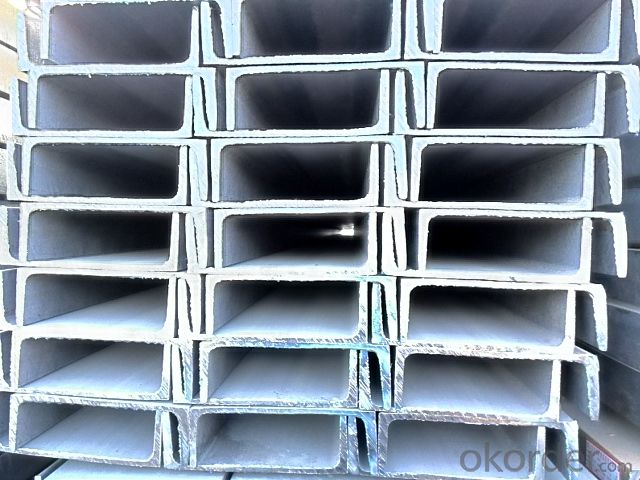
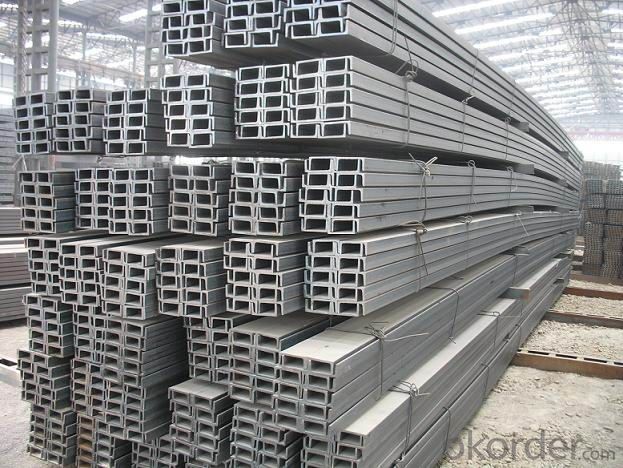
- Q: How do steel channels contribute to the overall safety of a project?
- Steel channels play a crucial role in enhancing the overall safety of a project in several ways. Firstly, these structural components provide robust support and reinforcement to various structures, such as buildings, bridges, and infrastructure projects. The strength and durability of steel channels make them capable of withstanding heavy loads and extreme weather conditions, minimizing the risk of structural failure or collapse. Moreover, steel channels are fire-resistant, which is a significant advantage in terms of safety. In the event of a fire, steel channels can withstand high temperatures for an extended period, offering valuable time for evacuation and minimizing the spread of flames. This fire resistance property makes steel channels highly suitable for projects where fire safety is a critical concern, such as high-rise buildings, industrial facilities, and transportation infrastructure. Another important contribution of steel channels to project safety is their ability to resist corrosion. Steel channels are typically made from galvanized or stainless steel, which are highly resistant to rust and corrosion. This resistance ensures the structural integrity of the channels over time, reducing the risk of deterioration and potential hazards. Consequently, projects utilizing steel channels can enjoy a longer lifespan and require less maintenance, ultimately enhancing safety and reducing the need for costly repairs. Additionally, steel channels offer versatility in design and construction. They can be easily customized and fabricated to suit specific project requirements, allowing for precise and secure connections between various structural elements. This versatility ensures accurate alignment and integration of components, minimizing the chances of structural instability or compromise. Lastly, steel channels provide excellent load-bearing capacity, enabling the distribution of weight and stress evenly across a structure. This even distribution of loads prevents localized points of weakness or excessive strain, thereby enhancing the overall stability and safety of the project. In conclusion, steel channels contribute significantly to the overall safety of a project by providing robust support, fire resistance, corrosion resistance, versatility in design, and excellent load-bearing capacity. By incorporating steel channels into construction projects, the risk of structural failure, fire hazards, and deterioration can be greatly minimized, ensuring the safety and longevity of the project.
- Q: What are the different joining methods for steel channels?
- There are several different joining methods for steel channels, including welding, bolting, riveting, and adhesive bonding. These methods are used to securely connect steel channels together for various applications in construction, manufacturing, and other industries. Each joining method has its own advantages and considerations, depending on factors such as load requirements, structural integrity, and ease of installation.
- Q: Can steel channels be used in telecommunications towers?
- Steel channels are indeed applicable in telecommunications towers. Their strength, durability, and versatility enable a range of uses. In terms of structural support, steel channels provide stability and the ability to bear heavy loads for the tower. By fabricating and assembling the channels, they form the framework of the tower, allowing for the installation of diverse equipment like antennas, transmitters, and receivers. Moreover, the design of steel channels allows for seamless integration of cables and wiring, thereby facilitating efficient connectivity throughout the tower. Ultimately, the incorporation of steel channels in telecommunications towers guarantees a robust and dependable infrastructure for effective communication networks.
- Q: How is the channel steel set on the wall?
- Method of channel steel mounted on wall:According to the size of the channel, the hole is opened on the wall, and then the channel steel is fixed in it.Can also buy some steel plate, size and channel size matching, in four corners hit four eyes, and then use expansion screws fixed on the wall, the two sides should be symmetrical, and then channel welding in the above.
- Q: Excuse me, when the high voltage cabinet is installed, should the base channel (10#) be placed upright or upside down? Are there any rules?
- This project high voltage switch cabinet model is KYN28, altogether 14 surfaces, including the breaker cabinet 9 sides, the voltage transformer cabinet 4 sides, turns over the line cabinet 1 sides.In this project, all low voltage power distribution cabinets are selected GCS type according to the design requirements, totaling 38 faces. The capacitor cabinet has 6 sides. This type of distribution cabinet is compact in structure and strong in protection.
- Q: How do steel channels contribute to the stability of a structure during hurricanes?
- Steel channels contribute to the stability of a structure during hurricanes in several ways. Firstly, steel channels are known for their high strength and load-bearing capacity. They are widely used in the construction industry to provide structural support and reinforcement. During hurricanes, when strong winds and intense forces are exerted on a building, steel channels help distribute these forces evenly throughout the structure. This prevents concentrated stress points and reduces the likelihood of structural failure. Moreover, steel channels are often incorporated into the framing of walls, roofs, and floors of a building. These channels create a rigid framework that enhances the overall stability of the structure. This rigidity helps the building withstand the lateral forces and uplift pressures generated by hurricane winds. By resisting these forces, steel channels minimize the risk of the structure collapsing or being severely damaged during a hurricane. Additionally, steel channels can be strategically placed in critical locations within a building to reinforce specific areas that are prone to wind and storm damage. For example, they can be used to strengthen window and door openings, which are vulnerable to wind pressure. By installing steel channels around these openings, the structure becomes more resistant to the uplift and inward forces caused by high-speed winds, reducing the likelihood of these openings being blown out or compromised. Furthermore, steel channels are highly durable and resistant to corrosion, making them ideal for withstanding the harsh environmental conditions associated with hurricanes. Unlike other construction materials, steel channels do not deteriorate or weaken when exposed to moisture, saltwater, or high humidity levels. This longevity ensures that the structural integrity of the building remains intact, even after multiple hurricane events. In summary, steel channels play a crucial role in enhancing the stability of a structure during hurricanes. Their high strength, load-bearing capacity, rigidity, and resistance to environmental conditions make them an essential component in the construction of hurricane-resistant buildings. By effectively distributing forces, reinforcing critical areas, and maintaining their structural integrity, steel channels help protect structures and their occupants from the destructive forces of hurricanes.
- Q: What are the different load combinations for steel channels?
- The different load combinations for steel channels include dead load, live load, wind load, seismic load, and temperature load. These combinations are essential for designing and analyzing the structural integrity and stability of steel channels.
- Q: Can steel channels be used for railway tracks?
- No, steel channels are not suitable for railway tracks. Railway tracks require specific rail profiles that are designed to withstand the weight and movement of trains, and to provide stability and durability over long distances. Steel channels lack the necessary properties and dimensions required for railway tracks.
- Q: What are the different types of steel channel accessories?
- There are several different types of steel channel accessories that are commonly used in various industries and construction projects. Some of the most common types include: 1. Brackets: Steel channel brackets are used to provide additional support and stability to the structure. They are typically used in combination with steel channels to secure them in place and prevent any movement or sagging. 2. Connectors: Steel channel connectors are used to join two or more steel channels together. They come in various designs, such as corner connectors or straight connectors, and are used to create a strong and secure connection between the channels. 3. End caps: Steel channel end caps are used to cover the exposed ends of steel channels. They provide a finished look to the structure and also help protect the channel from any damage or corrosion. 4. Mounting hardware: Steel channel mounting hardware includes various types of bolts, screws, and brackets that are used to attach the steel channels to walls, floors, or other surfaces. These accessories ensure a secure and stable installation. 5. Clips and clamps: Steel channel clips and clamps are used to secure cables, pipes, or other equipment to the steel channels. They provide a reliable and organized way to manage and secure various components within a structure. 6. Hangers: Steel channel hangers are used to suspend or hang different equipment, pipes, or cables from the steel channels. They are commonly used in HVAC systems, electrical installations, and plumbing applications to provide support and prevent sagging. 7. Slotted channels: Slotted steel channels are designed with slots or holes along the length of the channel. These slots allow for easy and adjustable mounting of various accessories, such as brackets, clamps, or hangers, without the need for additional drilling or modifications. Overall, these steel channel accessories play a crucial role in enhancing the functionality, stability, and appearance of steel channel structures in a wide range of applications.
- Q: Industrial plant pipe hanger expansion bolts, why add a section of channel, and then connect the screw rod?. The outer expansion bolt of the embedded beam is connected with a section of channel steel, and then the steel bar is hung under the channel steel. Why do you want to do this? What are the advantages?
- Safety and stability analysis is the first form of support, a little better, attention is to consider a firm point
Send your message to us
U-Channels Hot Rolled with Highest Quality
- Loading Port:
- Tianjin
- Payment Terms:
- TT OR LC
- Min Order Qty:
- 25 m.t
- Supply Capability:
- 10000 m.t/month
OKorder Service Pledge
OKorder Financial Service
Similar products
Hot products
Hot Searches
Related keywords
